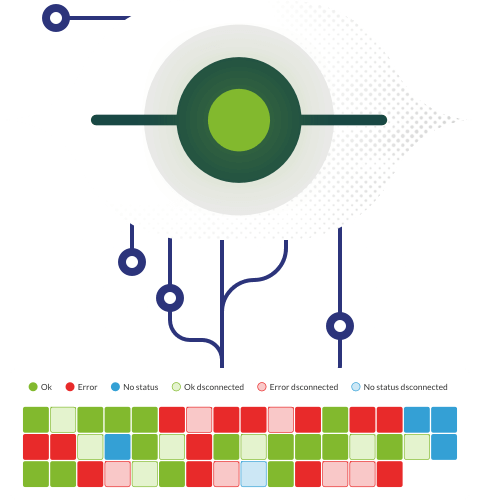
Cloud Computing is a service offered by several software providers paying a rent either by the hour, month or use of said service. They can be virtual machines, databases, web services, or other cloud technologies. These services are on remote servers provided by companies such as Google, Microsoft and Amazon among others that for rental or in some cases free of charge, provide such services. It is very convenient to have these services, since from a mobile phone or a not very sophisticated machine, you can have access to important services of all kinds just by having access to the internet.
- Services provided in the cloud
- How Cloud Computing Works
- Services available
- Examples of Cloud Computing
- Source of the term “Cloud Computing”
- History of Cloud Computing
- Importance of the Cloud
- PLeading Cloud Providers
- Key Elements of Cloud Computing
- Multi-Cloud Computing
- Benefits of Cloud Computing
- Advantages and disadvantages of Cloud Computing
- Widespread Adoption of Cloud Computing
- Challenges and Future of Cloud Computing
- Conclusion
Services provided in the cloud
The most common services provided in the cloud are as follows:
- Storage in the cloud. Where the service allows multiple files, images, or other data to be stored in the cloud. It’s kind of like an internet-connected super hard drive.
- Cloud Databases. You may access servers or databases such as SQL Server, PostgreSQL, MySQL, Oracle, etc. Note that you no longer need to access the entire server with the operating system (which is also possible). NoSQL databases, which are databases that do not use a relational database, can also be accessed. Instead of using tables, it uses documents or value keys to save the information.
- Data Lake. The Data Lake service is, as the name suggests, a data lake. You may have structured, unstructured and semi-structured data. These services are used to manage what we know as Big Data. That is, lots of information. Today, data can no longer be handled in traditional databases exclusively without very large amounts of information. That is why other storage media such as Data Lakes are used.
- Data analysis. Tools for analyzing data are also provided. There are tools for reporting, analytics using Machine Learning and other technologies.
- Software in the cloud. There is the possibility of programming in different languages using cloud services. There are platforms to upload the code and websites.
- Data Integration Services. Services such as AWS Glue, Google Cloud Data Fusion and Azure Data Factory among others, are services that allow you to integrate data. That is, copying data from one database to another or to a text file, moving data from a Data Lake to a database, etc.
- Network Services. Networking services help connect on-premise applications with cloud applications. These services provide connectivity, security, and scalability. Some services offer gateways between the local network and the cloud. There is also the Virtual Network Gateway service. It connects the virtual network and the cloud. Another common service is the Load Balancer which distributes traffic between servers. There are also other Networking services such as application links, traffic handlers, etc.
- Other Services. There are an infinite number of cloud services such as Machine Learning, AI, IoT…
How Cloud Computing Works
Saving is important. Instead of spending money on a good server or infrastructure, you may directly rent these cloud computing services. While the costs of renting cloud services from major vendors like Azure, AWS, and Google may seem high for small and medium-sized businesses, there are savings in staff.
A smaller team of IT professionals is required to maintain applications in the cloud. No time is wasted on hardware or many other aspects of security. While cloud service providers are not 100% responsible for security, much of the responsibility lies with them. They take care of the replications, of changing the hardware. Through a simple payment you may make your database server support more people connected simultaneously. That, in a local environment, would imply the purchase of new expensive servers and migrating information from one place to another.
Changing old hard drives, renewing servers, hardware problems, all of that is solved with the cloud, where you no longer have to worry about that aspect. Basically, it’s paying for the service and using it.
Services available
Some basic services are Microsoft 365 offering MS Word in the cloud, Excel, Word, PowerPoint, Outlook, OneNote, Publisher and Teams among other cloud applications. For example, documents in Excel are no longer saved on the hard drive but in the cloud. That is, on Microsoft Azure, servers to which you connect from your machine using the Internet.
Google offers Google Workspace which is similar to Microsoft 365. For example, it provides Google Sheets (a kind of online Excel), Google Docs (similar to MS Word), Gmail (similar to Outlook for emails), Google Slides (similar to MS PowerPoint).
Here are some of the many applications in the cloud. However, the cloud goes much further. It can offer Windows Servers, Linux. Databases of all kinds, whether relational or NoSQL, analytics services, IoT, Devops, websites, application programming platform, data analytics service, Machine Learning, APIs, cloud software and much more.
Examples of Cloud Computing
In everyday life we have been using cloud services for a long time. For example, Hotmail was the first service to use cloud technology. The concept of the cloud was not used then, but emails were stored on remote servers. Then came Yahoo’s mail services, Gmail.
Eventually Microsoft 365 arrived where it was already possible to use Word, Excel, PowerPoint, etc. using cloud technology. Then with AWS, Azure, Google Cloud and other providers, there are endless cloud services already mentioned above.
Source of the term Cloud Computing
Many people ask: what is the cloud? The term cloud computing is actually a metaphor. Since the 1960s, a cloud has been used to represent networks. Since 2000, the word has become popular and in a way indicates that the network is in heaven. That is, it is not within your physical reach but in another place that you may access through the internet.
History of Cloud Computing
As early as the 1960s, to represent networks, a cloud was used to represent them when they were connected to computers. However, it was not until the 1990s that the term began to be used to describe software as a service (SaaS). Through the service, machines connected to the internet without having to manage it from their computers.
However, the term became popular starting in 2000 with the rise of virtual machines and network computing. Cloud computing encompasses the multiple services offered on the network.
Importance of the Cloud
Large companies are taking their chances on the cloud. Microsoft for example upgraded its technology certifications to the cloud. The technologies located in the physical company have already been removed from the list of Microsoft certifications. Amazon on the other hand started in the cloud and was a pioneer. The trend is to spend less on an IT team and spend more on the rental of cloud services. Every year, the use of cloud services will grow more. According to Gartner, in 2025, 51% of IT services spending. They will be invested in the cloud.
Leading Cloud Providers
The following table shows the top cloud service providers and their market percentage:
|
Vendor |
market percentage |
|
33,3 % |
|
|
21,1 % |
|
|
9,2 % |
|
|
8,4 % |
|
|
6,5 % |
|
|
5,9 % |
|
|
4,7 % |
|
|
3,1 % |
As it can be seen in the table, AWS remains the leader and Microsoft maintains a second place. Google is in third place.
Key Elements of Cloud Computing
There are several types of services, which are IaaS, PaaS and SaaS. Below, we describe each one:
- IaaS (Infrastructure as a Service) provides access to cloud services such as servers, storage, and networking. In this type of service, users are responsible for installing, configuring and managing the software and applications that are used.
- PaaS (Platform as a Service) provides a complete platform for developing, running, and managing applications. In Paas, users are responsible for developing the application, however, the cloud provider is responsible for the underlying infrastructure and services.
- SaaS (Software as a Service) provides access to complete applications over the Internet. The user does not have to install or manage the software, as all this is handled by the cloud provider.
Multi-Cloud Computing
Large companies usually choose to purchase different services from different cloud service providers. It is very common for a company to have services in Microsoft, Google and AWS. This is due to different factors such as price, IT service technical skills, some special offers from vendors, etc. Fortunately, major vendors are not very different from each other in their services.
Benefits of Cloud Computing
The main benefit is that users will not waste time on hardware maintenance, buying hardware, scaling and migrating servers. Business and IT teams will focus on business and applications. They’re not going to waste a lot of time on computer installations and configurations.
Advantages and disadvantages of Cloud Computing
As advantages, we already talked about a work reduction in software installation, security, installation time and hardware purchase. However, we hardly talked about the disadvantages.
In many cases, they are very expensive services. It is very common to hear jokes from people who say they went bankrupt for forgetting to turn off cloud servers. And there are services so expensive that they are paid by the hour, which, if you forget to turn them off, the cost increases considerably.
For example, suppose you have a cloud service that costs $100 an hour. $800 per day for 8 hours of use. However, imagine that the employee who uses it, forgot to turn off the machine in the cloud, that can make the service charge you $2,400 a day instead of $800. Another problem is that staff must be trained because if a hacker gets in the cloud, they can access all business information, which would make your company and its computers utterly vulnerable.
Widespread Adoption of Cloud Computing
There is a clear upward trend in the use of cloud services. In 2020, according to Gartner, 20% of the workload was handled by the cloud. In 2023, this figure doubled. Despite increased competition from cloud providers, the demand for cloud services and the benefits of companies offering these services are steadily increasing.
Challenges and Future of Cloud Computing
There are several challenges of cloud computing. IoT, or the internet of things, handles sensors. One may detect for example the status of the machines, maintain inventory, review production, track products. The use of cloud APIs, artificial intelligence services, is increasing. The cloud provides quite a few services and these are constantly increasing.
Conclusion
Cloud computing offers a host of services such as: data analysis, artificial intelligence services, web pages, application server, development platforms, DevOps and lots of others. The trend is to migrate much of the on-premise infrastructure to the cloud.
Daniel Cabilmonte is a writer expert in technologies. Lecturer, consultant, blogger. He is passionate about software and technology. He writes about IT topics, security, programming, AI, BI.












